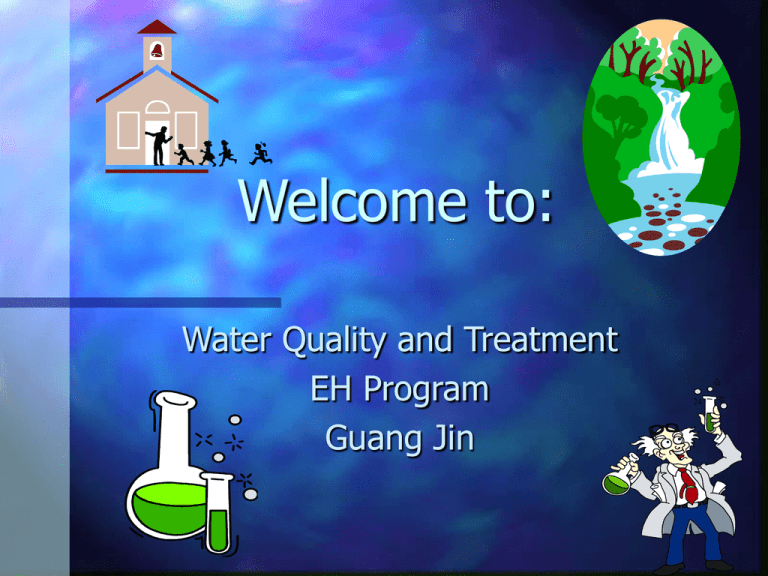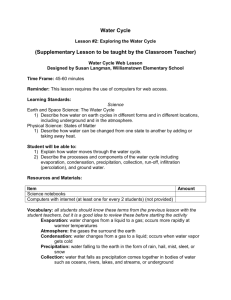Introduction to Water Quality
advertisement

Welcome to: Water Quality and Treatment EH Program Guang Jin Introduce Yourself What makes you to choose this course? What do you expect to get out from this course? I. Water Quality A. A History of Water Quality Source of water and changes in water quality throughout history Objectives Students should be able to: – Describe the source of water on Earth. – Describe how water quality has changed throughout history due to human actions Source of Water on Earth About 3 billions years ago, the Earth cooled enough for hydrogen and oxygen to combine in the atmosphere to form water. Torrential rains occurred for millions of years, washing salts and other minerals into low areas to form lakes, rivers and oceans. Changes in water quality throughout history Physical, chemical, and biological “contaminants” have always been present in water in low concentrations. Human activities have changed water quality dramatically because of high population and synthetic chemicals. Changes in water quality throughout history Several major changes in the past few hundred years have changed water quality dramatically: – changed in animal population – changes in plant populations – introduction of “persistent” and biomagnified” synthetic chemicals, and other human wastes. Destruction of animal populations Beavers once slowed rates of water runoff and allowed percolation of water Prairie dogs and other rodents allowed quick recharge of groundwater through borrows. Buffalo and other grazers created “wallows” to create groundwater recharge zones Freshwater mussels filtered water to improve water quality Changes in plant population Vast forests once captured water and released it slowly into the environment Vast grassland prairies also slowed movement of water through the environment. Agricultural “monocultures”, plowing, and damming of rivers created changes in both plant and animal populations Human-made Wastes Human designed synthetic organic chemicals which are “persistent” in the environment. Humans capture, use, contaminate, treat, and release tremendous quantities of water. These wastes contain organic chemicals which can imbalance the natural ability of water to clean itself (BOD, or Biochemical Oxygen Demand) Summary While some water had always contained organic and inorganic contaminants, human population has increased them significantly in the past few hundred years. Introduction of “persistent” synthetic compounds and other human wastes has created imbalances in natural systems designed to purify water. B. Aqueducts and Reservoirs A brief history of drinking water treatment and protection Objectives Student should be able to: – Describe the history of water sources, treatment, and protection in the U.S. and Europe. Early water supplies: As early as 2500 B.C., the Sumerians brought clean water from the mountains for irrigation and drinking purposes. Roman aqueduct systems are a model of engineering efficiency (simple yet effective). However, early Europeans had poor quality waste treatment and water supplies. Water, waste and disease Early civilization knew that clean water supplies were essential to good health. The relationship of human and animal wastes to waterborne disease was not firmly established until the late 1800’s. example of cholera(caused by Vibrio cholera) Typhoid fever (caused by Salmonella typhi) was a problem in the U.S. Early water sources in the U.S. Most early U.S. cities such as Boston, got their drinking water from well, which rapidly became polluted with waste. Like Europe, early U.S. cities were subjected to waterborne illness epidemics. Cities which had relatively clean water supplies, such as Philadelphia, were noticed to have much lower illness rates. Early water treatment Evidence of primary water treatment was found in Egypt as early as 2000 B.C. Pliny described the use of alum and lime for water treatment in 77 A.D. In Englande, use of alum for purifying drinking water was common. In Bolton, Englande in 1881, flocculation was used to treat drinking water. Early water treatment in the U.S. In 1892, Poughkeepsie N. Y. whose water source was the Hudson River, used sand filtration for purifying drinking water. In 1893, when Lawrence, MA, added water filters, and death rate for typhoid fever fell from 134 to 30 per 100,000. Allen Hazen of Boston found in 1903 that death rates for other illness also dropped. Disinfection of water supplies The Union Stockyard company of Chicago was sued by City of Chicago for poaching municipal water. The stockyard started using water from sewage-polluted Bubbly Creek by adding first copper sulfate, then chloride of lime. Cattle first lost weight, then thrived, and use of chlorine for disinfection was begun. Summary The value of clean drinking water supplies has been realized for thousands of years. Physical (filtration, sedimentation) and chemical (flocculation) treatment of polluted water supplies was shown to dramatically reduce the prevalence of waterborne illness. Disinfection (chlorine) was the final step in reducing waterborne illness. C. Importance of water, its unique properties, and its distribution on Earth Objectives Students should be able to: List and describe unique characteristics of water than make it essential for life. Discuss the unequal distribution of available freshwater on the Earth and the U.S. Importance of Water Most organisms are 60-65% water by weight. Water is vital for agriculture, manufacturing, climate, etc. Life could not exist without water. 71% of the Earth is covered by water Water is the major feature of the Earth seen from space. Unique properties of water Liquid over wide temperature range. (BP = 100oC, FP = 0oC) Temperature buffer Heat exchange (climate) Polar solvent Expand when it freezes. Distribution of world water Distribution of water on Earth 97% of water is in the oceans. 3% is freshwater Only 0.003% is easily available as soil moisture, usable groundwater, or in lakes, rivers, and streams Assume that all water on Earth is represented by 100 liter (26 gal.) – less than one gallon would represent al freshwater – less than one teaspoonful would be readily available freshwater – Large portions of readily available freshwater are polluted or inaccessible The distribution of water on Earth is unequal Iceland has an abundance of water from precipitation The Middle East has severe water shortage The Northwest U.S. gets large amounts of rainfall due to mountains. The southwest U.S. has severe water deficiencies Summary Water is essential to living things and is chemically and physically unique. Quality water is extremely limited and is unequally distributed in the United States and on the Earth. D. The Hydrologic Cycle Objectives Student should be able to: Describe and/or diagram the hydrologic cycle and distinguish its components. Discuss the importance of the hydrologic cycle for purification of water on Earth The Hydrologic Cycle: This is a global, natural system in place for purification of water on Earth, and has several key elements: – Evaporation (Liquid to gas) – Condensation (gas to liquid) – Precipitation (rain, snow, sleet, etc.) – Infiltration, percolation, runoff. Evaporation Evaporation is conversion of liquid water into water vapor. – This process distills the water, leaving contaminants behind. Evaportranspiration is evaporation of water from leaves of plants and soils – functions due to surface tension drawing water from soil to roots and to leaves. Condensation Absolute humidity is the amount of water that a volume of air can hold. Relative humidity is the amount of water in air compared to the maximum it could hold at a particular temperature The dew point is the temperature at which moisture begins to condense from the air. Precipitation Moisture condenses on small particles to form condensation nuclei. Droplets combine until gravity causes them to fall to Earth (rain, snow, sleet). 15 trillion liters of water (4 trillion gallons) of water fall on the U.S. every day. Infiltration, percolation, runoff About 66% of precipitation evaporates. About 31% runs off land into lakes, rivers, etc. and eventually, the ocean. About 3% percolates through soils into groundwater. Some water infiltrates into soils and remains as soil moisture The hydrologic cycle is powered by energy from the sun and gravity. – Solar energy evaporates water and forms water vapor. – Winds and air movement transport the water vapor. – Changing temperatures cause condensation and precipitation. How humans affect the hydrologic cycle Humans affect the hydrologic cycle in two major ways: – By withdrawing huge amounts of freshwater from well, lakes, streams, etc. (this may lead to water depletion or intrusion of salt water) – By cleaning vegetation for agriculture, mining, roads, etc. (decreases infiltration, percolation, increases runoff). Environmental factors that affect water quality and availability Climate - rain, snow, temperature, etc. Topography - hills, valleys, slopes, etc. Geology - soil, rock, minerals, etc. Geography - lakes, streams, cities, etc. Population - concentration of animals and plants. Water use - drinking, bathing, etc. Summary The hydrologic cycle is made up of several components including evaporation, condensation, and precipitation. The hydrologic cycle is a natural process that helps to purify water on Earth.








